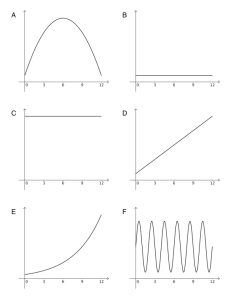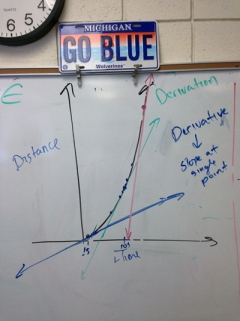 There’s a blog post from Reflections in the Why out there in which the blogger asks “Which graph best represents the importance of teacher knowledge of mathematical content as a function of grade level taught?”
There’s a blog post from Reflections in the Why out there in which the blogger asks “Which graph best represents the importance of teacher knowledge of mathematical content as a function of grade level taught?”
At the time (a year ago) I answered graph E. My reasoning:
The more I learn about high school math (second year teacher, now teaching Alg I, Alg II, Pre-Calc), the more I realize how nuanced upper level topics are. I sat in on a Calculus class and was blown away at the difficulty of it (coming from a math major!) – we’re not just cranking out derivatives here. While TEACHING each grade level requires specific knowledge of HOW students learn each topic, I think the complexity of the math itself increases. Probably not exponentially, but faster than linearly.
Now in my third year, I think I’m pretty much in the same place. I’d like to move that initial value in (E) way up though.
Of course, in a perfect world we’re all 4.0 math majors from highly reputable universities, no matter what level we teach. We all aced our Analysis/Theory of Calculus class (HA!) and can drop some sigma-epsilon proofs on 3rd graders if necessary.
Okay, maybe not.
 However, it’s still crucial we have that background. Because, then when you’re teaching 8th grade algebra and introduce slope, you can ask the question:
However, it’s still crucial we have that background. Because, then when you’re teaching 8th grade algebra and introduce slope, you can ask the question:
What is the slope right now? What is the speed right now?
You can reinforce the idea of average speed over a period of time vs. instantaneous speed at an instance. And you can then expect students to understand slope as an average rate of change, especially when you’re looking at data and lines of best fit and not the pretty, everything-works-out-to-a-round-integer-answer examples in the text book.
This was one of my more fun discussions of the year. Sure it was probably over the head of a third of the class. That’s okay. I’m sure even those that weren’t ready for it could see that we needed two points to calculate slope and this magical calculus I spoke of let us get slope with one point. Now, I’m primarily an 9-12 math teacher that teaches an 8th grade class. However, it is so, so important that any math teacher, in any grade, can make that calculus connection to rate-of-change, even if they’ve left behind the chain rule and related rates years ago.
You must be logged in to post a comment.